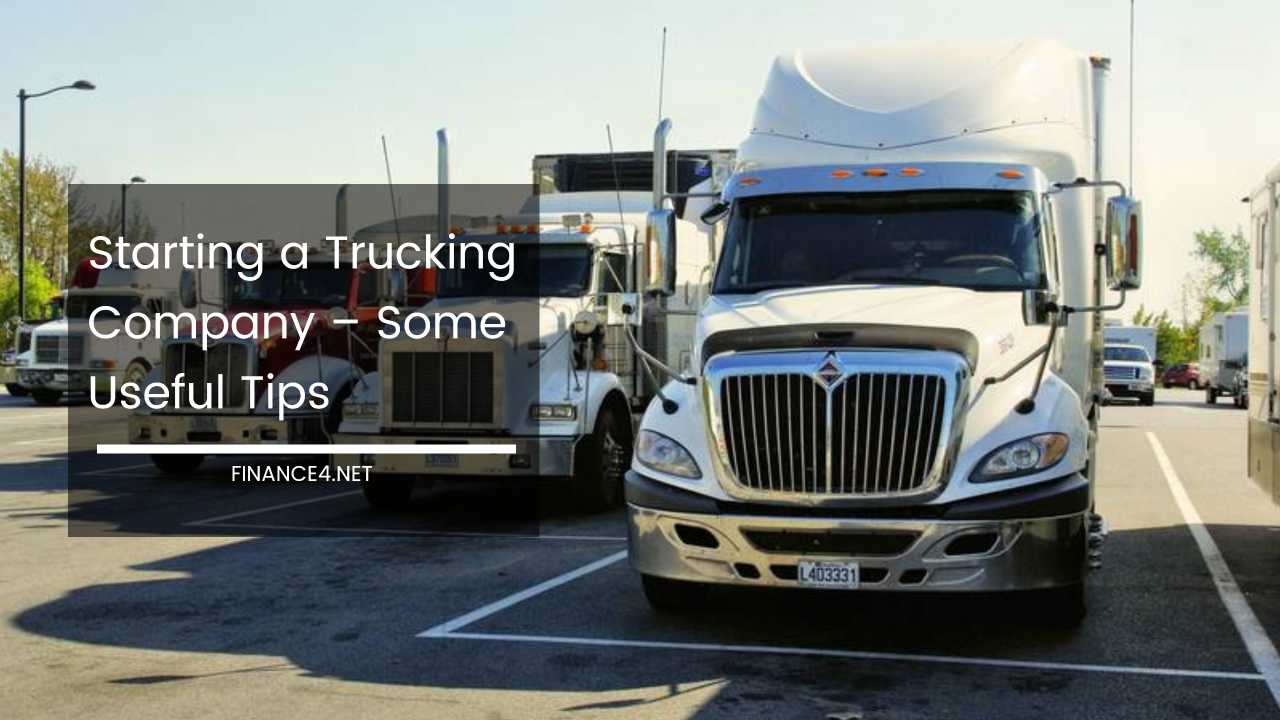Starting a Trucking Company – Your Roadmap to Success

The trucking industry is the lifeblood of the global economy, keeping store shelves stocked and vital goods moving across vast distances.
If you’ve been working in the industry and dream of being your own boss, starting a trucking company can be an exciting and lucrative path.
However, it requires careful planning, hard work, and a deep understanding of the logistics involved. This guide will equip you with the essential knowledge to navigate the process and turn your entrepreneurial vision into reality.
Planning for Success: Craft a Solid Business Plan
Your business plan serves as the blueprint for your trucking company’s journey. It outlines your goals, strategies, and financial projections, providing a clear direction for yourself and potential investors. Here are the key elements to consider:
- Market Research: Conduct a thorough market analysis. Research current trends, identify market gaps, and determine the type of freight in highest demand within your chosen geographic area (local, intrastate, or interstate). Analyze factors like infrastructure, industry concentration, and potential competition.
- Target Market: Define your ideal customer base. Will you focus on specific industries like manufacturing, retail, or agriculture? Will you specialize in hauling particular types of cargo (e.g., dry goods, refrigerated goods, oversized loads)? Understanding your target market allows you to tailor your services and marketing efforts.
- Competitive Analysis: Identify your competitors and assess their strengths and weaknesses. Analyze their pricing models, service offerings, and customer base. This will help you develop strategies to differentiate your trucking company and stand out in the market.
- Financial Projections: Create a realistic financial forecast that includes:
- Startup costs (trucks, trailers, permits, insurance)
- Ongoing operational expenses (fuel, maintenance, insurance, salaries, permits, and licenses)
- Projected revenue based on your target market, freight rates, and truck utilization (percentage of time trucks are loaded)
- Marketing Strategy: Develop a plan to attract customers. This might involve networking with freight brokers, shippers, and industry associations. Consider online advertising or attending industry trade shows to build brand awareness. Emphasize your unique selling proposition (USP), whether it’s cost-effectiveness, reliability, specialized equipment, or exceptional customer service.
Choosing Your Path: Deciding on Freight and Equipment
The type of freight you haul will significantly impact the trucks and trailers you need. Here’s a breakdown of some common options:
- Dry Van Trailers: These enclosed trailers are ideal for general cargo that doesn’t require temperature control.
- Flatbed Trailers: Used for oversized or odd-shaped loads that can’t fit within an enclosed trailer.
- Reefer Trailers: Equipped with temperature control systems, these trailers are essential for transporting perishable goods.
- Tanker Trucks: Designed to haul liquids, such as fuel, chemicals, or food-grade products.
Beyond the Basics: Specialized Equipment Considerations
Consider niche markets that require specialized equipment. For example, hauling hazardous materials necessitates hazmat-certified trailers and driver training. Similarly, lowboy trailers can accommodate extremely heavy equipment, while car carriers efficiently transport vehicles. Researching these options allows you to cater to a broader range of clients.
Securing Funding: Launching Your Fleet
Most trucking companies require significant upfront investment to purchase trucks and trailers. Consider these financing options, with additional tips:
- Self-Funding: If you have the personal capital, this is the most straightforward approach. However, be sure to maintain a healthy financial buffer for unexpected costs.
- Small Business Loans: Banks and credit unions offer loans specifically designed for small businesses. Research interest rates, loan terms, and eligibility requirements before applying.
- Equipment Financing: Lenders specialize in financing the acquisition of trucks and trailers. Negotiate favorable terms, including down payment requirements and interest rates.
- Investor Funding: Attract investors by presenting a well-developed business plan that highlights your growth potential, market opportunity, and management expertise. Be prepared to offer investors a stake in your company’s profits.
Building a Legal Foundation: Registering Your Business and Obtaining Permits
Operating legally is paramount. Here are the crucial steps:
- Business Registration: Choose a business structure (sole proprietorship, LLC, or corporation) and register it with your state’s Secretary of State office. Consider the legal and tax implications of each structure.
- Licensing and Permits: Obtain the necessary licenses and permits required for your business type and the freight you plan to haul. These may vary by state but typically include a USDOT number, Motor Carrier Authority (MCA) number, International Fuel Tax Agreement (IFTA) decals, and International Registration Plan (IRP) tags. Research the Federal Motor Carrier Safety Administration (FMCSA) regulations that govern the trucking industry. Familiarize yourself with safety protocols, driver qualifications, and vehicle maintenance requirements.
Protecting Your Assets: Obtaining the Right Insurance
Trucking insurance is vital to safeguard your business from financial losses in case of accidents, injuries, or cargo damage. Key insurance types include:
- Commercial Auto Liability Insurance: Covers damages caused to others by your trucks in an accident. Consider increasing your minimum coverage limits to protect your assets.
- Cargo Insurance: Protects the value of the freight you haul in case of loss or damage. Choose coverage that aligns with the value of the goods you typically transport.
- Non-Trucking Liability Insurance: Provides coverage when your truck is not in operation but still poses a liability risk (e.g., parked at a loading dock).
Additional Insurance Considerations:
- General Liability Insurance: Protects your business from lawsuits arising from non-accident-related incidents, such as property damage or customer injuries at your terminal.
- Workers’ Compensation Insurance: Mandatory in most states, this insurance covers medical expenses and lost wages for employees injured while on the job.
Maintaining Compliance: Recordkeeping and Logbooks
Keeping meticulous records is essential for industry compliance and tax purposes. Here’s what you need to keep updated:
- Driver Qualifications: Ensure all drivers have valid commercial driver’s licenses (CDLs) with the appropriate endorsements for the type of vehicles they operate. Conduct regular driver safety training programs.
- Logbooks and Records: Maintain accurate logs of driver duty times, vehicle maintenance records, fuel purchases, and cargo manifests. Utilize electronic logging devices (ELDs) to ensure compliance with FMCSA regulations.
- Tax Filing: Establish a system for tracking income and expenses to ensure accurate tax filing. Consider consulting with an accountant for guidance on tax regulations specific to the trucking industry.
Building Your Network: Finding Consistent Freight Loads
Maximizing profitability hinges on keeping your trucks running and loaded. Here are strategies to secure consistent freight loads:
- Freight Brokers: Partner with freight brokers who connect shippers with carriers. They have access to a vast network of loads and can help you find loads that match your truck’s capabilities and location.
- Load Boards: Online load boards allow carriers to search for and book loads directly from shippers. Popular options include DAT, Truckstop, and LaneStar.
- Shipper Direct Sales: Develop relationships with local shippers in your target market. Negotiate contracts to transport their goods directly, eliminating the middleman and potentially increasing your profit margins.
- Industry Associations: Join industry associations like the American Trucking Associations (ATA) or the National Tank Truck Carriers (NTTC) to connect with potential customers and stay updated on industry trends. Network with other trucking companies to share resources and find backhaul opportunities (return loads) to maximize efficiency.
Building a Strong Team: Hiring and Retaining Qualified Drivers
The success of your trucking company hinges on your drivers. Here’s how to build a reliable team:
- Competitive Salaries and Benefits: Offer competitive salaries, benefits packages (health insurance, paid time off), and driver appreciation programs to attract and retain qualified drivers.
- Safe Work Environment: Prioritize safety by implementing comprehensive safety protocols, providing regular driver training, and maintaining your fleet in top condition.
- Positive Company Culture: Foster a positive work environment that values driver input and rewards performance. Clear communication, open door policies, and opportunities for professional development can increase driver satisfaction and reduce turnover.
Final Thoughts
Starting a trucking company requires dedication, strategic planning, and a comprehensive understanding of the industry. By following this roadmap, you can navigate the initial challenges and position your company for success.
Remember, the trucking industry is dynamic, so stay informed about market trends, adapt your strategies as needed, and continuously strive to provide exceptional service to your customers. With hard work and perseverance, you can turn your dream of owning a trucking company into a reality.



